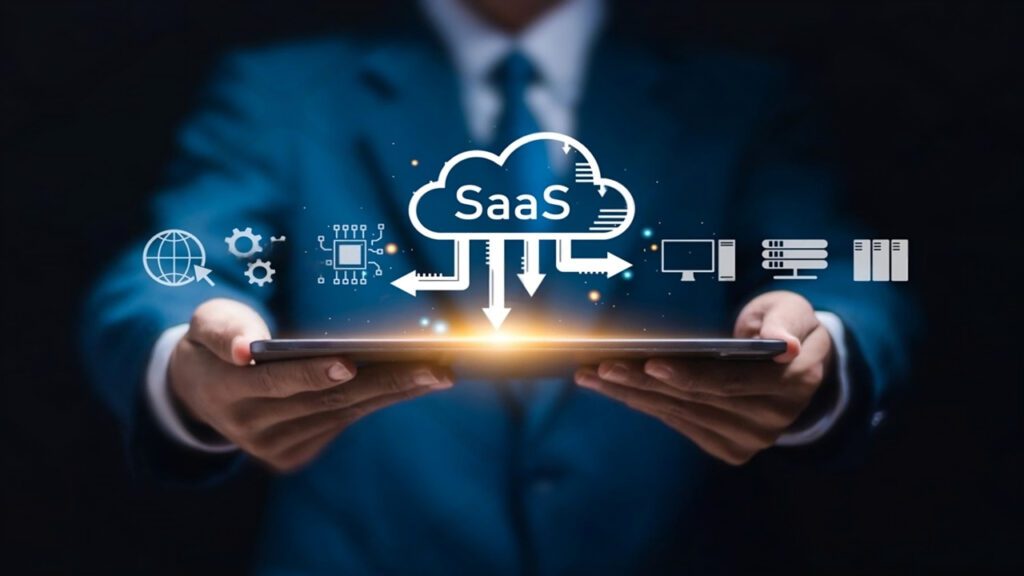
SaaS Application Development now powers how teams buy and use software. Companies want fast setup, steady updates and clear pricing. They do not want servers to manage or installs to maintain.
For founders and product leaders, this shift changes the work. Code still matters, but so do architecture, security, onboarding and support. Get those right and growth feels smooth. Miss them and churn rises.
This guide gives a practical path from first idea to a live, resilient service. You will learn the stages of SaaS Application Development, the habits that keep quality high and the choices that set you up to scale.
Table of Contents
ToggleWhat is SaaS Application Development?
SaaS Application Development is the end-to-end process of planning, building, launching, and operating a cloud service that user’s access by subscription. Unlike installed software, the provider owns uptime and ships updates continuously. The work spans product design, data modeling, privacy, billing and support, not just code.
In scope you will usually see
- A change process that ships often without drama
- Multi-tenant architecture with strict data isolation
- Web and mobile interfaces with fast, friendly flows
- Identity, roles and billing for recurring revenue
- Integrations and APIs that fit customer stacks
FACT: Buyers now ask for evidence of security and data handling before they trial a product, which makes early architecture and privacy choices critical business.
Why SaaS Development Matters
The pull toward cloud services is strong for clear reasons.
- Lower upfront cost
Teams pay monthly or yearly fees and avoid hardware. That keeps adoption friction low. - Faster improvement
With SaaS platform development, updates land in small, safe steps. Users see value sooner and trust grows. - Global reach
You can serve new regions without shipping boxes or doing site visits. Access is just a sign-in away. - Elastic scale
Cloud resources grow or shrink as demand moves. That keeps performance steady through peaks.
Now the hard truth. These gains only arrive when the foundation is sound. That is why a thoughtful approach to SaaS Application Development pays off quickly.
Key Steps in SaaS Application Development
A clear sequence keeps teams aligned and handoffs clean.
- Market research and validation
Understand who hurts, how often and what they use today. Confirm that your solution beats their current workaround in speed or clarity. - Planning and architecture
Set goals, risks and timelines. Choose tenancy, regions, and base stack. Draw a simple diagram that shows how requests flow. - Build the product slice
Create one thin, end-to-end path: sign-up, one core task, a simple billing step. Keep mergers small. Add unit tests as you go. - Readiness and quality
Automate tests. Add health checks and alerts. Write a short runbook for deploying and rollback. - Launch through SaaS implementation steps
Run a pilot with design partners. Roll out by cohort or region. Watch activation, errors, and time-to-value. - Operate and improve
Ship small updates weekly. Track usage, support themes and cost to serve. Feed lessons back into the next plan.
Architecture Principles that Scale
Strong patterns in SaaS Application Development reduce surprises later.
1. Tenancy and isolation
- Shared schema fits most products at low cost.
- Schema per tenant improves isolation for louder neighbors.
- Isolated databases suit premium or regulated customers.
Enforce tenant checks in services and at the data layer. Never trust the client to pass the right tenant id.
2. Stateless services
Keep compute stateless so scale is horizontal. Push slow work to queues. Make background jobs idempotent so retries never double charge or double send.
3. Performance
Profile at the ninety-fifth percentile. Cache hot reads. Batch chatty writes. Keep payloads small.
4. Reliability
Use circuit breakers for external calls. Add timeouts and backoff. Store audit trails for sensitive actions.
5. Security
Centralize secrets. Apply least privilege. Scan uploads. Sanitize user input. Treat privacy tools as core features, not extras.
6. Observability
Structured logs, useful metrics, simple dashboards. Your team should see trouble before users do.
Best Practices that Hold Up Under Load
These habits keep your service calm as usage climbs.
1. Design for first value
Make the first path short and obvious. Preload sample data. Show a finished state so users know what “good” looks like.
2. CI and small releases
Automate tests and ship often. Small changes fail smaller and roll back quickly.
3. Accessible UX
Readable type, clear contrast, keyboard support and helpful empty states. Access is part of quality.
4. Analytics with a purpose
Track activation, core task adoption and cohort retention. Ignore vanity counts. Let the data steer what you trim or expand.
Example: A workflow app cut onboarding steps from seven to four and added a sample project. Time-to-value fell from fifteen minutes to three and trials converted more often. That one change paid for a month of engineering time.
Table 1: Steps in SaaS Application Development and Evidence to Keep
| Step | Focus | Evidence you should keep |
| Market research | Pain, frequency, alternatives | Interview notes, top jobs to be done |
| Planning and architecture | Goals, tenancy, risks | One-page charter, diagram, risk log |
| Build slice | End-to-end path and tests | Working flow, unit tests, review notes |
| Readiness | Reliability and security | Alerts, runbooks, access policies |
| SaaS implementation | Safe rollout and adoption | Pilot plan, onboarding, billing checks |
| Operate and improve | Learning loop | Weekly release notes, KPI dashboard |
The Role of Pricing, Packaging and Billing
Pricing is part of product design. Treat it that way.
Choose a value anchor
Seats for collaboration. Usage for APIs. Plans that bundle limits and features. Tie at least one lever to outcomes customer’s feel.
Make upgrades smooth
Proration, instant entitlements and clear invoice detail. No tickets are needed to change plans.
Keep it visible
Publish a pricing page that maps features to jobs. Surface upgrade prompts at natural “aha” moments.
Between engineering and finance, isolate pricing and entitlements as data. Then changes do not need a deploy.
Data, Privacy and Compliance
Buyers expect proof that you handle data with care.
- Map personal data and sensitive fields during discovery
- Set retention windows and deletion paths
- Offer export and admin search
- Document were data lives by region
A little work here shortens security reviews and speeds deals.
Integrations and APIs that Earn Trust
Most customers need your product to fit their stack.
- Start narrow, go deep
Ship two great integrations at launch, then add one each month. Provide examples, webhooks, and rate limits per tenant. - Treat your API as product
Clear docs, error messages with fixes and stable versioning. When partners succeed, adoption grows.
Team and Cadence that Keep You Shipping
Small, focused teams win with steady habits.
- Product owns outcomes and the backlog
- Engineering owns quality with tests and fast review
- Design owns flows, empty states, and accessibility
- Support owns trends and closes the loop
Run weekly demos, short post-mortems, and one operating review. That rhythm turns ideas into improvements you can see.
Why SaaS Implementation Deserves Its Own Plan
A good build can still stumble at launch if rollout is messy. Treat SaaS implementation as a project with clear owners.
- Before launch
Practice deploys and rollback in staging. Check billing edge cases. Publish a status page and incident templates. - During launch
Release by cohort. Watch latency, errors and activation. Pause if your error budget starts to burn. - After launch
Publish weekly “what’s new” notes. Close design-partner issues. Capture questions and turn them into helpful articles.
Survey: Vendors that share a public roadmap and a monthly recap see stronger engagement. Customers value steady, visible progress more than big surprises.
Scaling Strategies that Do Not Break the Team
Growth touches tech, support and cash flow. Plan for all three.
- Infrastructure
Autoscale with floors so costs stay sane. Use read replicas and caches for spikes. Keep workloads stateless so traffic can move. - Operations
Set service level objectives for availability and latency. Spend error budget on learning. If you breach, pause features and harden the path. - Customer success
Onboard with short videos and in-app tips. Tag tickets by feature. Feed the top three themes into the roadmap monthly.
A steady weekly release cadence correlates with lower time-to-value and fewer incidents, because changes stay small and visible.
Table 2: Today’s SaaS vs Where It’s Going
| Aspect | Common today | Likely direction |
| Pricing | Subscription and freemium | Usage based with clearer value anchors |
| Architecture | Multi-tenant on cloud | Microservices when needed, serverless at the edge |
| UX | Web and mobile | Low-code customization and automation |
| Delivery | Pilot then phased rollout | Continuous global rollout with feature flags |
| Security | Compliance and encryption | AI-assisted monitoring and prevention |
Metrics that Matter More than Vanity
Measure a few signals tied to real outcomes.
- Activation within seven days
- Time to First Value
- Weekly active teams or projects
- Feature adoption tied to retention
- Net revenue retention and gross churn
- Cost to serve per tenant
Teams that review these signals weekly and choose one improvement to ship each cycle compound wins without burning out the roadmap.
Common Mistakes and Fast Fixes
- Overbuilt MVP
Ship one end-to-end slice first. Add depth later. - Messy multi-tenancy
Enforce checks at the service and data layers. Add tests that prove isolation. - Integrations as an afterthought
Plan one or two at launch. Document your API like a product. - No clear price-to-value link
Tie at least one lever to a customer outcome. Make upgrades obvious and reversible. - Support seen as a cost only
Treat support as a product surface. Tag themes and fix root causes.
A Practical SaaS Implementation Playbook
A smooth rollout turns good engineering into real adoption. Use this three-step track and keep proof for each step.
1. Pre-launch readiness
Write a one-page runbook. Include deploy steps, rollback steps, and owners by name. Wire health checks and alerts before switching traffic. Validate billing with sample invoices and proration. Practice a full rollback in staging so muscle memory exists.
PRO TIP: Put the runbook next to the code so version history stays in sync with releases.
2. Soft launch with design partners
Invite a small cohort that matches your ideal customer. Migrate a silver of real data. Meet weekly for thirty minutes. Fix friction inside the same week. Share a short changelog so progress stays visible.
Example: A reporting tool ran a two-week soft launch with eight finance teams. Early issues around CSV import surfaced fast and were fixed before public release.
3. Public release and the first ninety days
Release by region or plan. Watch activation, time to first value, error rate on writes, and p95 latency. Publish weekly “what is new” notes in app. Turn the top three support themes into improvements every sprint. After ninety days, hold a review and reset your north star based on what you learned.
Enterprise Readiness Without Slowing Down
- Access and identity
Offer SSO, SCIM user sync and granular roles. Keep a clear map of which roles can read, export, or delete data. - Audit and governance
Record admin actions and sensitive reads. Make exports self-serve for auditors. Keep a short document that explains where logs live and how long you keep them. - Data controls
Document residency options by region and where moves. Provide admin tools for export and deletion requests. - Procurement basics
Publish an uptime history, incident process and support SLAs by plan. A simple one pager here removes weeks from long sales cycles.
FACT: Buyers often have confidence on how fast you answer security and uptime questions, not only the features you list.
International Readiness That Scales
- Localization
Separate copy from code and translate with keys. Support pluralization and right to left where needed. Localize dates, currencies and number formats. - Payments and tax
Enable local payment methods where adoption is high. Show tax on invoices and store tax ids. - Latency and support hours
Place data and compute near users when possible. Publish office hours by region and keep a small knowledge base in each target language.
Survey: Products that ship localized onboarding see higher activation in new regions because customers reach first value faster.
Observability, Incidents and SLOs
Define service level indicators that reflect what users feel. Availability per region, p95 save time and error rate on writes are good starters. Set service level objectives, then give yourself an error budget.
If you burn through it, pause features and harden the path. During an incident, declare, triage, mitigate, communicate and review. Close the loop within forty-eight hours with a short public note that names the cause and the preventive action. Customers measure trust by how you behave under stress.
Performance and Cost Discipline
Speed is a feature and margin is freedom. Profile at the ninety fifth and ninety ninth percentiles. Cache hot reads and paginate heavy lists. Push slow tasks to queues and keep jobs idempotent. Track costs to serve by tenant and by feature so you can prune expensive paths. Kill unused indexes and chatty queries before you scale traffic.
Add a performance budget to every epic. If a change threatens latency, redesign early rather than buy bigger servers later.
Final Thoughts
SaaS Application Development is a craft that blends product truth with platform rigor. The teams that win validate the problem, design for multi-tenancy and automate tests and deploys, so small changes land often.
As you grow, treat SaaS development choices as business levers. Keep privacy visible, let data drive the roadmap and make SaaS implementation a predictable project rather than a fire drill.
With clear owners, steady cadence and customer focused decisions, your work in SaaS Application Development becomes a durable engine for growth that users trust every day.


